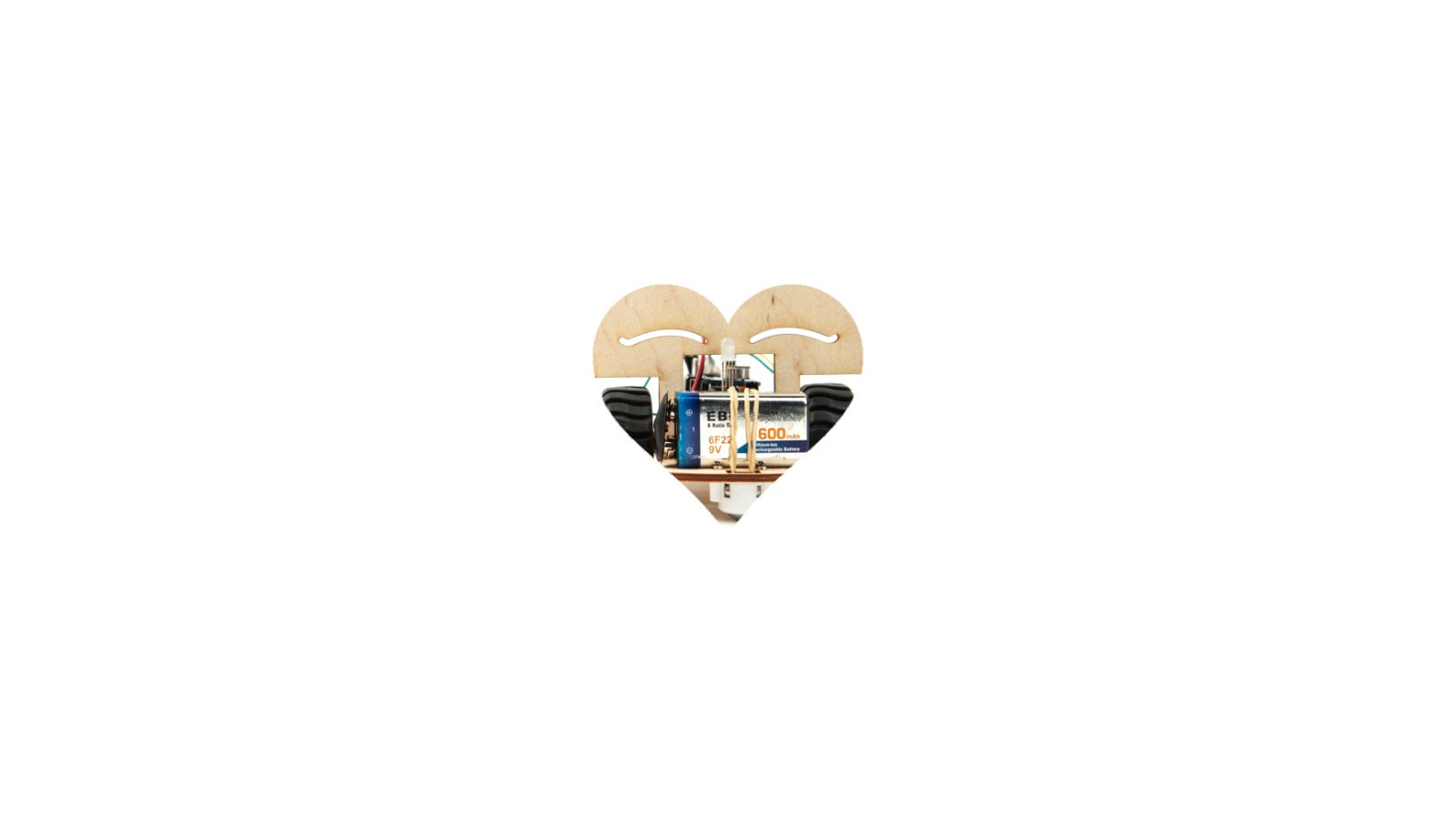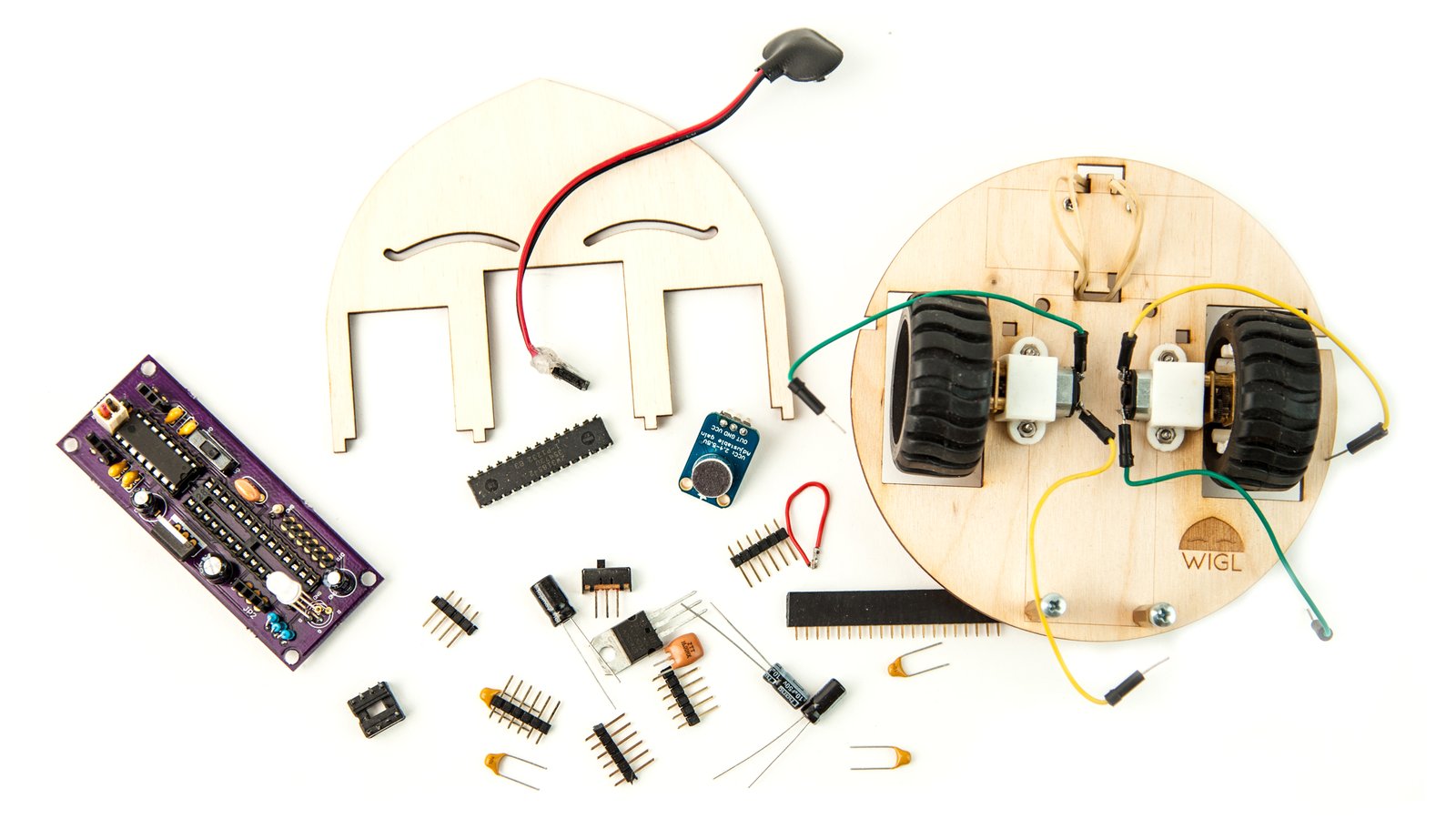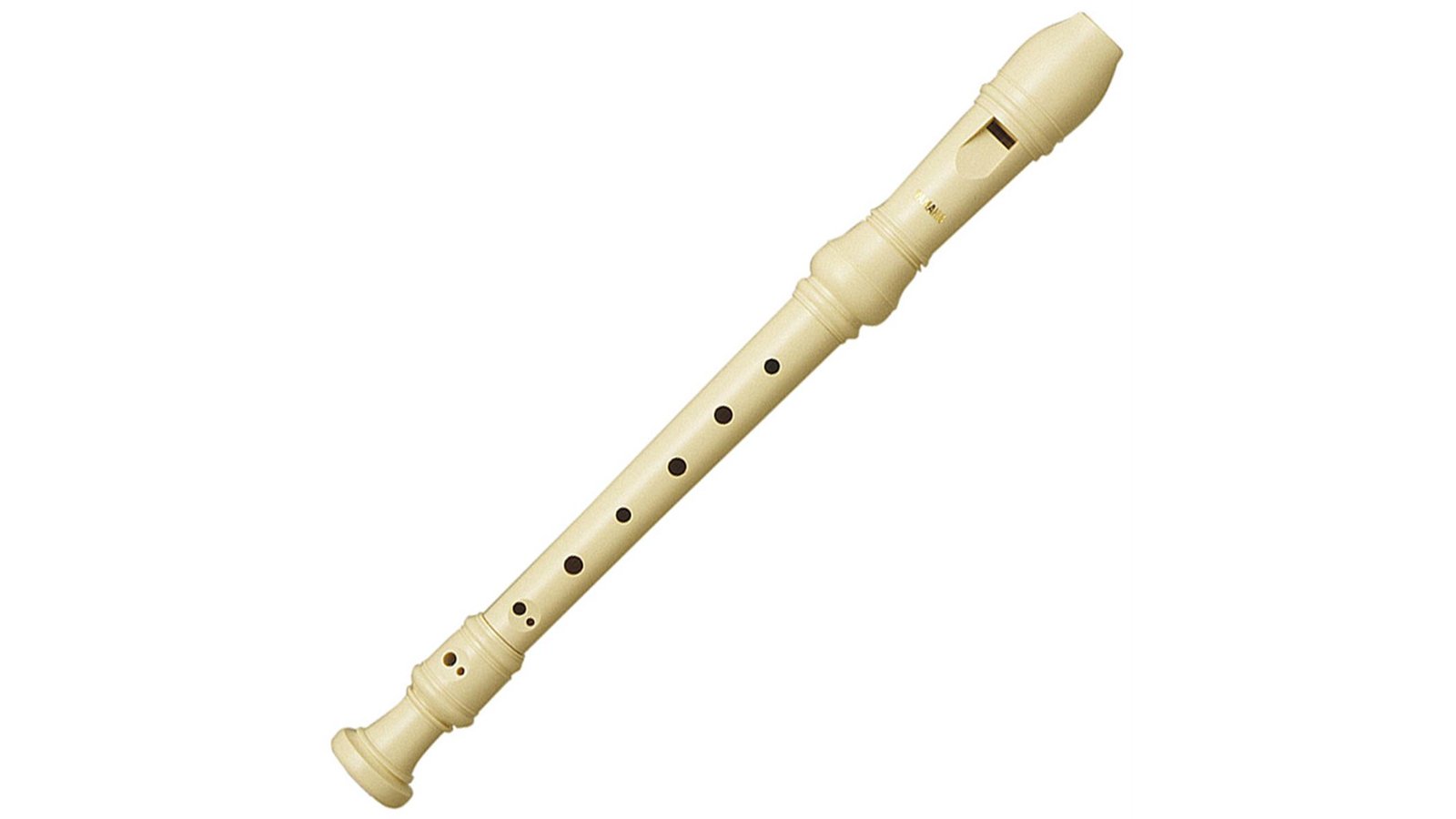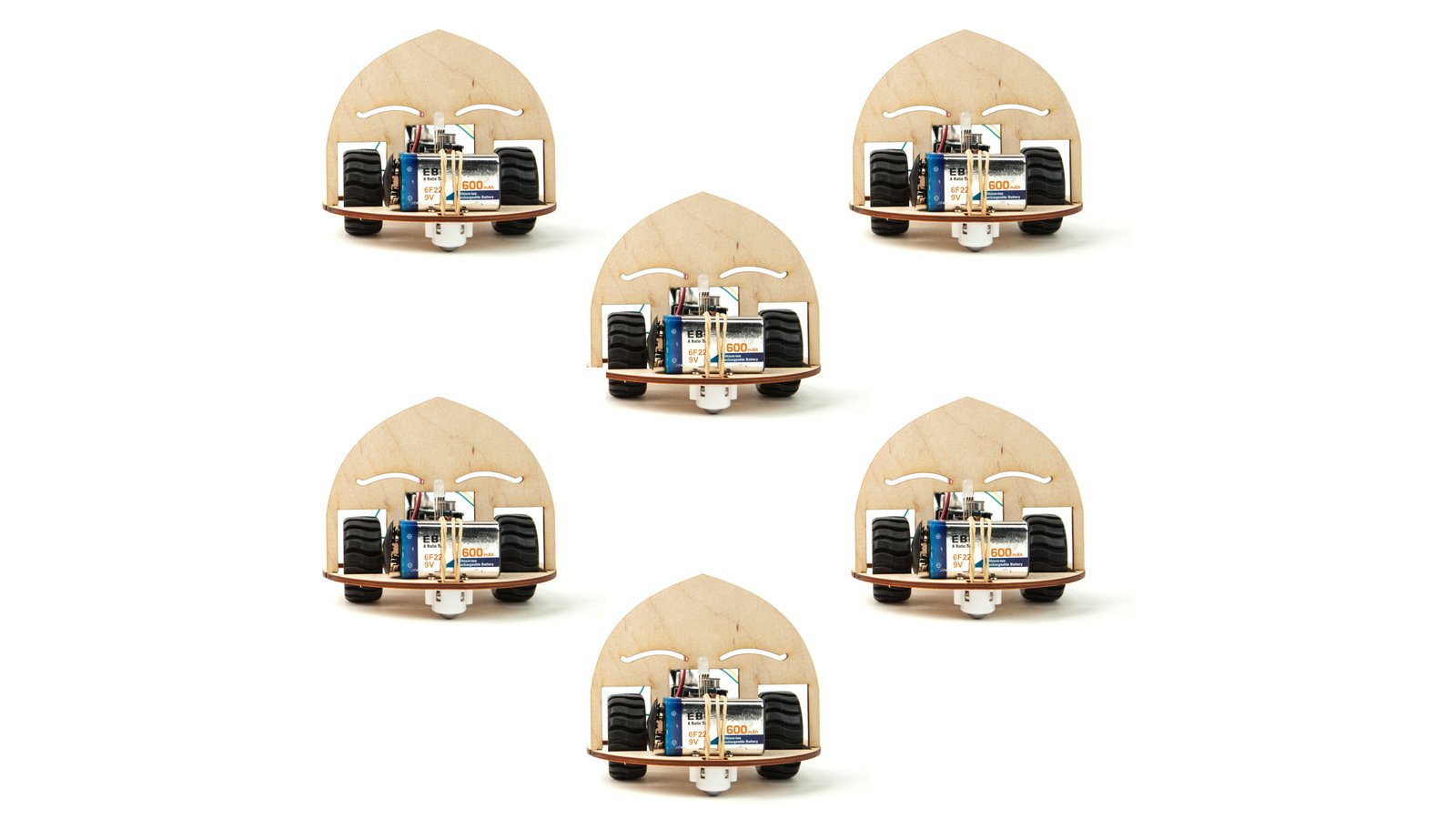Wigl hears notes from any instrument and responds with movements, lights, and special dances! Wigl helps to motivate kids and adults to practice their instrument. Through sequenced musical notes, you can program special dance moves for Wigl. This combination of right brain creativity with left brain logic makes this a unique robot for any family.
Wigl has a microphone, a microcontroller (brain), and some motors for movement. Wigl is ALWAYS listening for musical notes and, through some complex math, it can hear individual music notes.
Wigl has two built-in modes:
When Wigl hears a musical note it knows, it moves and lights up. Specific notes make Wigl move in specific ways. For example, an A note might move Wigl forward, while a D moves Wigl backward. If you play a series of notes together to form a song, Wigl celebrates with a special dance!
In this mode, rather than moving when it hears a note, Wigl “hears” the note and stores it in memory. Every note played is memorized, like lines of code in a computer program. Then, to run your Wigl program, you play a special "ENTER" note, and watch Wigl go!
This is a fun way to problem solve (e.g., Wigl’ing out of a maze) and teach kids the basics of coding: notes as pseudo-code! More advanced users can modify the code in the Arduino sketch to associate different responses with different notes.
Offering an educational tool in kit form adds additional levels of learning, awe, and project ownership to the entire experience. Wigl can be put together with just a soldering iron, basic screwdrivers, some glue if you want to permanently attach a head, and any art products you might want to decorate it with. The entire kit will take about 1-2 hours to complete - and all components are through-hole, so they require only the most basic soldering skills. Depending on the age of the builder, the soldering may need to be done by an adult.
Note: the kit does not include a 9V battery.
The Wigl PCB schematics, board layout, and base Arduino code are freely available on GitHub (https://github.com/vivekmano/wigl). The laser cutting files will also be published during the campaign (along with some extra head options we considered). Wigl was designed to be hacked, decorated, and modified- so we want to provide you with as many tools to learn as we can.
I’m an engineer, and I can see that there is a worldwide shortage of quality engineers. People seem to believe that strong math skills are the most important prerequisite for being an engineer. However, I think that creative problem solving is far more important, and is really the foundation of engineering. With Wigl, we can develop this skill and get kids excited about engineering!
Today’s robots for children require a separate screen interface (e.g., a computer, smartphone, tablet) for control, which causes the majority of their attention to be focused on that screen. We want to reduce screen-time, and we believe that direct interaction with an educational robot will enhance their learning and creativity.
My 3rd grade music teacher gave me my first musical instrument, the recorder. Learning to play clean notes, practicing mundane songs… none of this was fun. Plus, it was frustrating since I had to practice in a room by myself. I wished I had a musical buddy who would enjoy my attempts and dance to my music.
Fast forward to 20 years later, and I still had that same desire (now with the ukulele). But this time, Wigl was there to help me out. If I didn’t play a note correctly, Wigl wouldn’t move. This motivation to see Wigl dance around kept me practicing, and even led me to learn songs!
After the first prototype was built in July 2013, we started testing the unit with the Renaissance School in Portland, OR. The kids loved the robot and had lots of suggestions, but it didn’t have a name (or a face) yet.
With the help of some wonderful designers, we began implementing the kids’ input and creating the outer form that you see today. From sketch, to clay mold, to 3D print, Wigl was born!
The past months have been spent testing Wigl with hundreds of children and parents at local schools, museums, and children’s events. We’ve taken all of that feedback and input and invented what we believe is a truly unique learning experience.
In November 2013, we entered Wigl into the Oregon Technology Business Center’s (OTBC) Electronic Systems Pitch competition and were awarded the grand prize for our technology approach and business model.
A few months later, in March 2014, we entered Robohub / SV Robo’s international Robot Launch 2014 competition and won two awards, including the "Leanest Startup" award for frugal use of funds while updating Wigl through continuous customer feedback.
The positive reception, both from the kids and the startup community, has given us the confidence to bring Wigl to classrooms and homes everywhere.
Hi! I’m Vivek Mano, the creator of Wigl. I’m an Electrical Engineer from the University of Florida. While at UF, I created my first robot, an autonomous tennis-ball retrieving robot. Since then, I’ve had fun building various other hobby robots.
For the past 8 years, I have been involved in sales, marketing, and business development within the industrial automation industry (big robots). But my background, and my passion, is in embedded electronics and robotics (smaller robots). Being able to combine both experiences is what led to Wigl.
Wigl has had many iterations, this final kit version was designed to be as simple to manufacture as possible. The electronics have been well tested, and the sourcing and manufacturing have been planned. That being said, there’s always the possibility of delays in delivery, manufacturers sending the wrong items, or necessary components being inexplicably backordered. Fortunately, we have workarounds for almost any of these eventualities.
Will Wigl work with any instrument?
YES! Wigl listens to everything: recorder, guitar, ukulele, flute, fiddle, bagpipes, a singer’s voice… anything that produces musical notes can control Wigl. However, Wigl cannot distinguish individual notes from percussive instruments, such as drums.
How is Wigl powered?
Since Wigl is propelled by high quality DC motors, it uses a 9V battery for its power supply.
How does Wigl hear songs?
Just like the celebration dance to "The Lion Sleeps Tonight" in the movie, Wigl dances when it hears complete songs and song snippets. Wigl listens for the correct sequence of notes, and if it likes what it hears, you’ll know it!
Which notes does Wigl listen for?
Wigl listens for E5, F5, G5, A5, B5, C6, and D6.
Produced by Vivek Mano in Portland, OR.
Sold and shipped by Crowd Supply.

Give us a little Wigl if you support engineering and education.

The dancing robot itself - the kit includes all the necessary parts to build a robot and get Wigl moving to your tunes. Just bring a soldering iron, solder, and a 9V battery.

A basic plastic recorder - the simplest tool to get Wigl moving, and to learn some notes on.

Enough kits for the whole class to work together in teams to build real, musical robots. Collectively, a group of Wigl can be referred to as a Wag.
I’m an Electrical Engineer from the University of Florida. While at UF, I created my first robot, an autonomous tennis-ball retrieving robot. Since then, I’ve had fun building various other hobby robots.